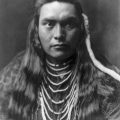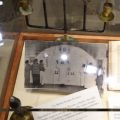
Among the tribes of the western portion of the Northeastern Woodlands, tobacco was an important ceremonial and trade plant. Tobacco smoking is a symbolic way of enhancing the communication between individuals, between groups, and between the people and the supernatural. Tobacco smoke rose from the pipe for the use and comfort of the spirits. All ceremonies involved the use of tobacco as an offering and/or through the smoking of the pipe.
Indian people in the Great Lakes area have been raising tobacco and using pipes for smoking tobacco for thousands of years. With regard to the ancestors of the Ho-Chunk (Winnebago) who were living in the Lake Winnebago area a thousand years ago, George Quimby, in his book Indian Life in the Upper Great Lakes, 11,000 B.C. to A.D. 1800, reports:
“Tobacco pipes were made of polished stone, usually of catlinite, but occasionally of soapstone and sandstone. All of these pipes were of the disk-shaped variety.”
Catlinite is a reddish sedimentary rock found at Pipestone, Minnesota and in northern Wisconsin. Ceremonial pipes usually have a long wooden stem.
One of the reasons for its ceremonial importance is explained in the Ho-Chunk (Winnebago) creation story.
The Ho-Chunk are a Siouan-speaking people whose aboriginal homeland was just south of the Great Lakes in Wisconsin. Like the other Indian nations of this region, they had a mixed subsistence economy which included farming, hunting, fishing, and gathering wild plants. In addition to raising corn (maize), beans, and squash, they also raised tobacco.
According to the Ho-Chunk creation story, after the Earthmaker had created all other things, human beings were created. Human beings were the least of the Earthmaker’s creations. They were put in charge of nothing. While even the smallest of the insects could see four days ahead, human beings could not even see one day ahead. Then the Earthmaker created a weed with a pleasant odor and all of the spirits wanted it. The weed was called tobacco. Earthmaker then showed the people how to use it, how to crush it, and smoke it in a pipe. To all of the spirits Earthmaker said:
“Now, whatever human beings ask from me and for which they offer tobacco I will not be able to refuse it. I myself will not be in control of this weed. If they give me a pipe full of this and make a request I will not be able to refuse it.”
Earthmaker also told the spirits:
“The human beings are the only ones of my creation who are poor. I did not give them anything, so therefore this will be their foremost possession and from them we will have to obtain it. If a human being gives a pipe full and makes a request we will always grant it.”
Among all of the tribes of this culture area, tobacco is used for all important activities. This includes sprinkling of tobacco on the water as an offering to the underwater spirits just before getting into a canoe; offering a pinch of tobacco to the earth where other ceremonial plants are gathered; providing tobacco to someone when a special request is made. When humans upset balance and harmony, tobacco is used to restore spiritual order.
The oldest form of tobacco which was cultivated and used in this culture area was Nicotaina rustica. This tobacco, often described as “strong-tasting”, was cultivated in small patches and was used in religious ceremonies. According to archaeologist Mark Wagner, in his chapter in Stone Tool Traditions in the Contact Era:
“Many Native American groups reserved N. rustica for use in religious and other ceremonies while using the commercially obtained N. tabacum for recreational smoking.”
Nicotaina rustica was originally domesticated in the Andes Mountains of South America about 6,000 to 8,000 years ago and diffused to North America about 2,500 to 3,500 years ago. Nicotaina tabacum was originally cultivated in Brazil and was introduced to North America by the Europeans who raised it as a commercial crop. European traders often traded Nicotaina tobacum to the Indians.




Leave a Reply